With a significant amount of precipitation in the warm season, it is required to begin the fight against various diseases in advance. This is required because late blight, powdery mildew, scab and other diseases can appear in the garden next year. Dampness permeates everything. It brings with it fungal spores and other infectious diseases. They disperse in the beds, garden and greenhouses. It is required to get rid of infection - plant breeders apply copper sulfate (CuSO₄ · 5H₂O). This powerful fungicide helps get rid of harmful insects.
Content
Why land treatment with copper sulphate in autumn
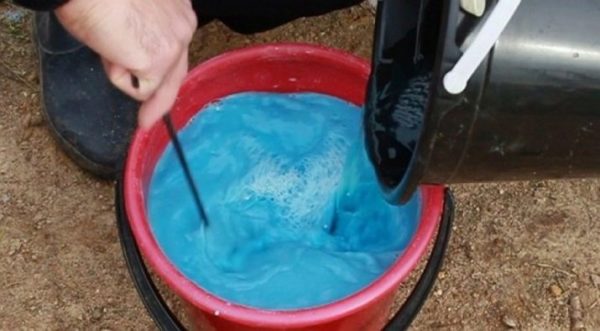 In order to prevent the spread of pathogens of infectious diseases in the garden, gardens and greenhouses, copper sulfate is used in small volumes. She has the following action:
In order to prevent the spread of pathogens of infectious diseases in the garden, gardens and greenhouses, copper sulfate is used in small volumes. She has the following action:
- Vegetation has some protection against disease.
- Fungal spores are eliminated, and with the concomitant use of binders - a solution of laundry soap, copper sulfate remains on the foliage and shoots, preventing the fungi from fixing on them.
- When treating the soil with copper sulfate, the soil characteristics increase, and plants, subject to the microaddition of copper, better absorb nutrients.
- Plants that underwent treatment with copper sulfate in the fall tolerate the winter season more easily.
But it is forbidden to use copper sulfate constantly during autumn processing. This compound has a tendency to accumulate and can have the opposite effect:
- Significant concentrations of copper in the soil lead to a disorder in the interaction of a number of macro- and microelements.
- There is a violation of soil permeability to air and the amount of absorbed nitrogen from the environment decreases.
- Copper sulfate in excessive concentrations in the soil slows down the distribution of phosphorus preparations, which fertilized the plot.
- In the upper soil layer, the life of the microflora is inhibited - aerobic microorganisms begin to process the organic component worse. Decay slows down.
- Iron oxide does not actually enter the vegetation due to copper substitution.
Pros of autumn application
In the autumn, treatment is carried out for prevention. The time for the implementation of the event is chosen after the leaves fall completely from the trees. At the same time, the site should already be completely cleaned and prepared for the winter season.
Spraying fallen leaves leads to the fact that a solution of copper sulfate affects the fungal spores present and completely destroys them.
Also, the processing of copper sulfate garden or garden in the autumn season has other positive aspects. For the cold season, insects hide in the tree bark and soil near the roots of the vegetation.
In order to guarantee the prevention of a pest attack on horticultural crops next year, it is required to treat the following areas with solutions of copper sulfate:
- priming;
- shoots of plants;
- crevices and cracks of the bark.
Processing the site with copper sulfate makes it possible to eliminate single representatives of harmful insects. The drug also destroys pest colonies in areas where parasites concentrate in preparation for hibernation.
Properties and composition
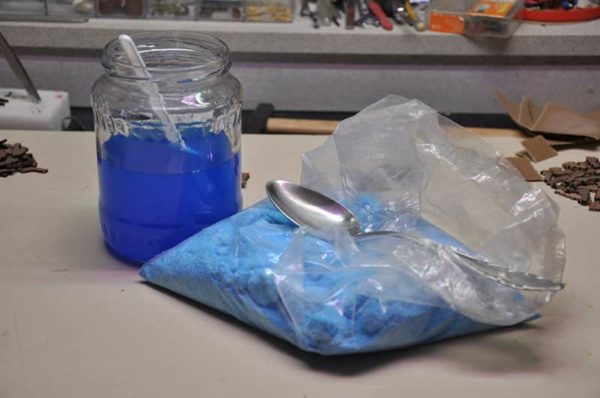 Copper sulfate is an inexpensive drug that is sold in hardware stores and organizations selling products for plant growers. It is sold in the form of blue or deep blue crystals.
Copper sulfate is an inexpensive drug that is sold in hardware stores and organizations selling products for plant growers. It is sold in the form of blue or deep blue crystals.
When the crystalline substance is heated, liquid evaporates from them and they acquire a lighter shade. With prolonged heating, the substance becomes faded gray. Copper sulfate is a non-combustible material, but in some situations it is explosive.
The properties of crystallized copper sulfate are as follows:
- the substance rapidly dissolves in the liquid;
- quickly absorbs water - significant hygroscopicity;
- soluble in alcohol and hydrochloric acid.
Copper sulfate is a strong toxic substance, the handling of which requires increased care and absolute adherence to safety regulations.
Concentration
Copper sulfate in crop production is used in the form of solutions. Often mixed several options for liquid preparations. The main difference with a solution of copper sulfate is the proportional content of crystalline matter in water.
Feeding composition
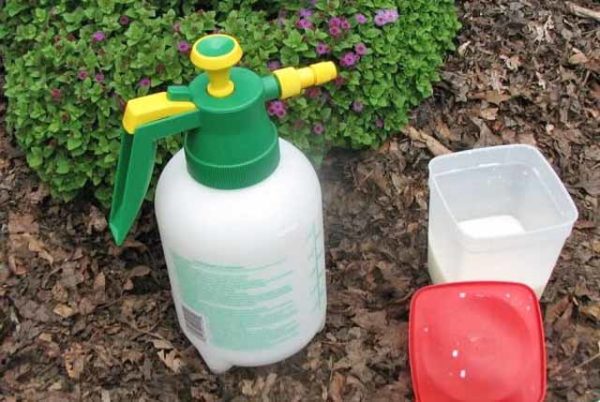 Concentrations from 2 to 3% are the composition that is used for fertilizing and fertilizing the soil. Gardeners and gardeners often achieve this content of copper sulfate by adding 20-30 g of copper sulfate per 10 l of water.
Concentrations from 2 to 3% are the composition that is used for fertilizing and fertilizing the soil. Gardeners and gardeners often achieve this content of copper sulfate by adding 20-30 g of copper sulfate per 10 l of water.
In addition to this, such a composition is used as a prophylactic and concomitant restoration of copper balance in the land of a personal plot.
Medical
When receiving the medicinal composition of copper sulfate, plant breeders dissolve about 5-10 g of crystalline substance in 10 l of water. The result is a solution with a concentration of from 0.5 to 1.0% copper sulfate.
This concentration of copper sulfate solution is used when it is required to initiate the healing process of vegetation wounds after autumn pruning.
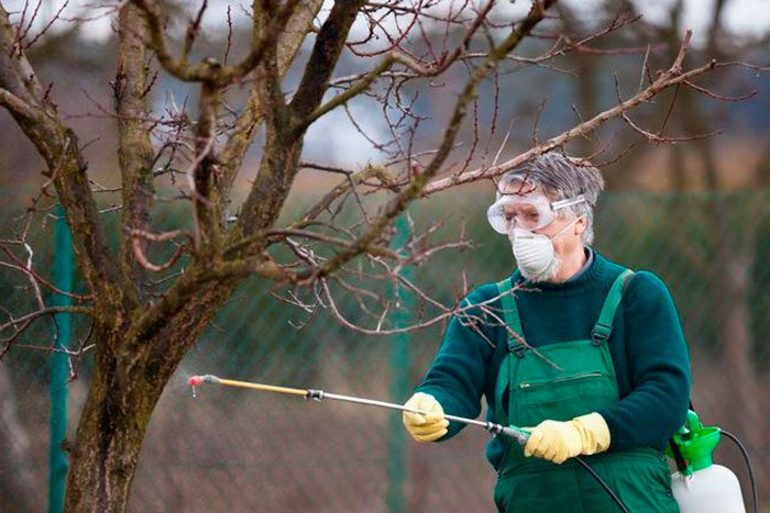 You may be interested in:
You may be interested in:Scorching
The concentration of the burning out solution is from 4 to 6% of copper sulfate. This content is achieved by adding from 40 to 60 g of crystalline substance in water. This tool produces the processing of beds, soil and tree trunks of cultivated trees.
Clever gardeners and gardeners recommend abandoning the use of territories that are treated with a powerful 4-6% solution of copper sulphate from turnover for 1 year. But, this is not necessary - excess volumes of copper sulfate pass into the lower soil layers before the beginning of active garden work.
Training
Copper sulfate acts as the basis of the Burgundy and Bordeaux compositions. In horticultural stores, it is possible to buy these solutions in the prepared form, but most plant growers prefer to dilute fungicidal mixtures with their own hands.
Burgundy squad
To make a Burgundy composition, you need to use the following components:
- copper sulfate;
- soda ash;
- laundry soap;
- water.
In a separate container, 100 g of copper sulfate in 5 l of heated water is first bred. In another container, 90 g of soda ash and 40 g of laundry soap in 5 l of hot water are diluted. Then, the solution with added vitriol is carefully poured into a container with laundry soap and soda ash. The resulting composition acquires a greenish color. After filtering it is used for processing soil and vegetation.
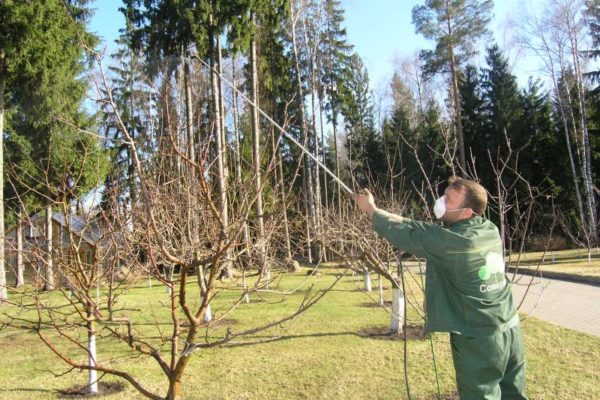 Burgundy composition is often used to process gooseberries and currants. This mixture gives the following effects:
Burgundy composition is often used to process gooseberries and currants. This mixture gives the following effects:
- Destruction of spores of pathogenic fungi and other pathogens of infections occurs.
- Contained calcium enriches the soil and is a good tool for the active development of plants for the next season.
- On foliage, the mixture does not last long and does not have such stickiness as Bordeaux.
This composition is not recommended to be used too often due to the presence of copper sulfate in it. Overly frequent use of copper sulfide leads to burns on plants.
Bordeaux squad
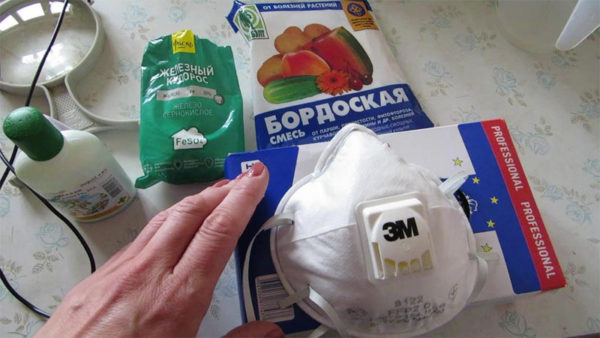 To prepare a fungicidal solution, you need to mix the following components:
To prepare a fungicidal solution, you need to mix the following components:
- copper sulfate;
- lime;
- water.
There are several concentration options - depending on the purpose. A 3% solution of vitriol is used for early treatment of vegetation, it consists of the following components:
- copper sulfate - 300 g;
- lime - 400 g;
- water - 10 l.
The gentle option for spraying is represented by a 1% Bordeaux mixture, which consists of such components:
- copper sulfate - 100 g;
- lime - 100 g;
- water - 10 l.
Key components are bred in separate containers. Heated water is used, but the temperature of the liquid should not exceed 50 ° C. First, the powder is dissolved in a small amount of water, and then the residue is slowly added, bringing to 9 l of the total volume. In another container, 1 liter of water is diluted with lime, and then the solid fractions are separated by filtering through gauze.
Before use, make sure that the mixture with vitriol has cooled. After cooling, a solution of copper sulfate is carefully poured into a vessel with lime. As a result, the composition should acquire a bluish color. Use Bordeaux liquid immediately after cooking. It helps prevent and get rid of the following:
- pathogens of rust;
- late blight;
- scabs and more.
Winegrowers often use Bordeaux mixture, as it does not cause burns to plants and destroys harmful insects and their larvae.
The nuances of the process
Regardless of the purpose of spraying with copper sulphate in the fall, during its dilution follow the exact algorithm and each rule. This is a guarantee of the harmlessness of the work performed. The basic rules of the process are as follows:
- It is forbidden to cook the solution in iron utensils, the only exception is enameled containers.
- Mix mixtures immediately before their use, since it is undesirable to store the finished composition.
- For the speedy dissolution of copper sulfate, warm water up to 50 ° C is used.
- The finished solution must be filtered, as it often contains insoluble precipitate.
- During the preparation and use of mixtures, personal protective equipment is required - a mask, glasses and gloves.
Soil treatment with copper sulfate and spraying of vegetation are not carried out in wet weather. Also, they do not perform these manipulations provided that the air temperature is above 30 ° C and during strong winds. This is explained by the fact that less active component settles on the vegetation, and the spray area expands significantly (some cultures do not need spraying).
Soil tillage in autumn
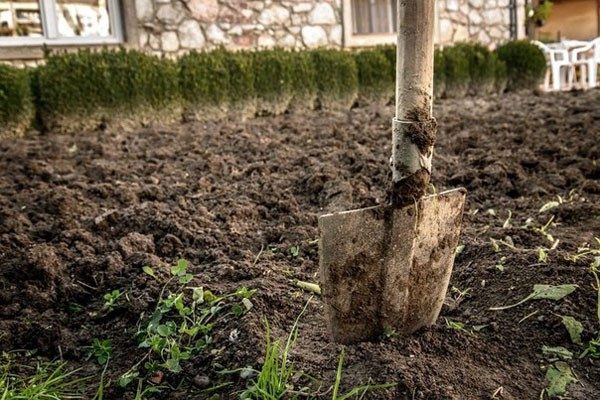 Spores and parts of the mycelium of harmful fungi winter in the ground. Such pathogens include such varieties:
Spores and parts of the mycelium of harmful fungi winter in the ground. Such pathogens include such varieties:
- Fusarium
- verticillosis;
- late blight;
- various rot;
- rust;
- spotting;
- scab and others.
To prevent the infection of garden and horticultural crops with these diseases, land plots in autumn are treated with copper sulfate. The drug provides not only protection to crops against infectious diseases, but also some resistance to harmful insects. In addition, solutions of copper sulfate partially repel rodents.
Copper sulfate is also used as microfertilizer. If it is present in the soil in the required volumes, copper positively affects the chemical composition and taste characteristics of the fruit.
Treatment of alkaline soil with copper sulfate is especially required. Since vitriol is an acid salt, the drug increases the acidity of the soil.
Copper has a drawback - it accumulates in soil, vegetation, and water. At excessive concentrations of this metal, plants experience a lack of iron, which leads to slow growth, falling leaves and ovaries.
A solution based on copper sulfate for soil preparation is prepared in 2 stages. First, 100 g of vitriol is diluted in 3-5 liters of heated water, and then liquid is added to the solution, bringing the total volume to 10 liters.
The site is treated with a mixture as follows:
- Remove all residues of vegetation related to annuals from the treated area.
- The site is dug up, the remains of rhizomes of weeds are removed, the clods of the earth are smashed as finely as possible.
- From a watering can, a solution is poured onto the ground with the calculation of 2 liters per 1 m2.
To enrich the soil with copper, a 0.1% solution of copper sulfate is used, that is, 100 g of copper sulfate per 100 l of water.
Tree processing
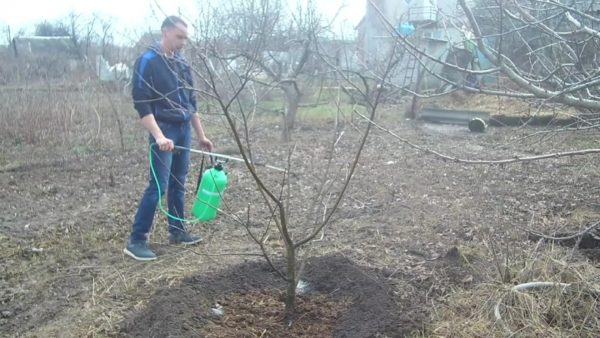 Spraying trees is a preventive and curative measure. It is necessary to take into account that fertilizers can be used only in the absence of precipitation, since the solution is easily washed off and on a rainy day the processing efficiency is minimal.
Spraying trees is a preventive and curative measure. It is necessary to take into account that fertilizers can be used only in the absence of precipitation, since the solution is easily washed off and on a rainy day the processing efficiency is minimal.
Copper sulfate is treated with stone and pome fruit bearing crops. It is also allowed to spray a mixture based on copper sulfate of such plants as:
- raspberry;
- roses;
- gooseberry;
- currant;
- Strawberry.
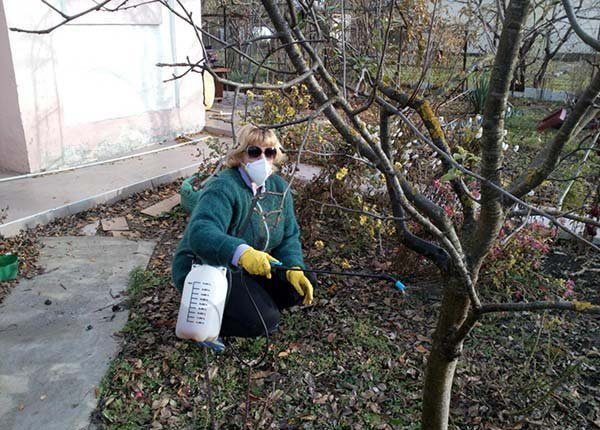 You may be interested in:
You may be interested in:When processing trees and shrubs, the mixture should fall on the ground under them and foliage (when harvesting of leaf litter is not planned). Processing is carried out 1 time in 3-4 years, the composition is used - 50-100 g per 10 liters. A similar concentration is required when spraying crops such as:
- plum;
- apricot;
- quince;
- cherry;
- Apple tree;
- sweet cherry;
- pear.
This mixture allows you to get rid of the following vegetation diseases:
- various rot;
- fungal diseases;
- scab;
- anthracnose;
- lichens.
The drug is less effective in the case of combating harmful insects.
Greenhouse processing
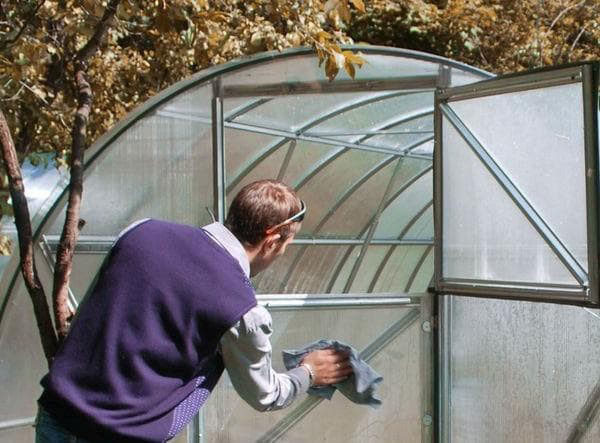 In the autumn period, greenhouses are treated with compounds based on copper sulfate. The greenhouse is washed with laundry soap, which dissolves in water. For a soap solution, 20 g of soap is diluted in 1 liter of liquid. In greenhouse soil, a solution of bleach is added, which contains 300-400 g of lime per 10 liters of water. On 1 m2 make 1 liter of the mixture.
In the autumn period, greenhouses are treated with compounds based on copper sulfate. The greenhouse is washed with laundry soap, which dissolves in water. For a soap solution, 20 g of soap is diluted in 1 liter of liquid. In greenhouse soil, a solution of bleach is added, which contains 300-400 g of lime per 10 liters of water. On 1 m2 make 1 liter of the mixture.
The following treatment involves the use of copper sulfate. The mixture is prepared in the following proportions: 50-60 g of a crystalline substance is diluted in 10 l of water. Consumption of the composition is 0.5 l / m2. After processing, repeated wet cleaning of the greenhouse is required.
The greenhouse soil treated with the product is dug up. Sometimes formalin is added 40% - 100 ml diluted in 10 liters of water. If the infection of the greenhouse with pathogenic elements is high, then the consumption can reach 20 liters per 1 m2.
Copper sulfate from parasites
Copper sulfate is a time-tested remedy for insect pests. Copper sulfate is a rather powerful fungicide, but it can also destroy parasites:
- moth;
- scabbard;
- aphids;
- leaf weevil.
In the fight against parasites, various concentrations of solutions based on copper sulfate are used. The percentage of copper sulfate in the composition is determined based on the estimated number of pests in the area.
Effects of processing
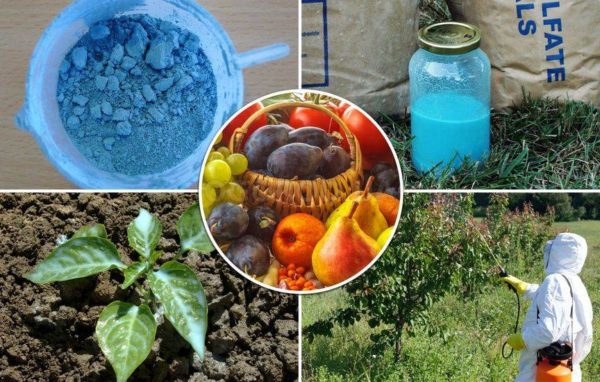 To prevent burns with vitriol in vegetation, it is often used in conjunction with slaked lime, that is, they prepare a Bordeaux mixture.
To prevent burns with vitriol in vegetation, it is often used in conjunction with slaked lime, that is, they prepare a Bordeaux mixture.
The abuse of copper sulfate products leads to the following consequences:
- lowering the quality characteristics of soil air exchange;
- increased nitrous emissions;
- decrease in the intensity of nitrogen metabolic processes in the soil;
- the growth of harmful organics.
In case of violation of the rules for the use of preparations based on copper sulfate, copper may accumulate in the soil, which will lead to the degradation of beneficial trace elements and the necessary microflora.
Safe use
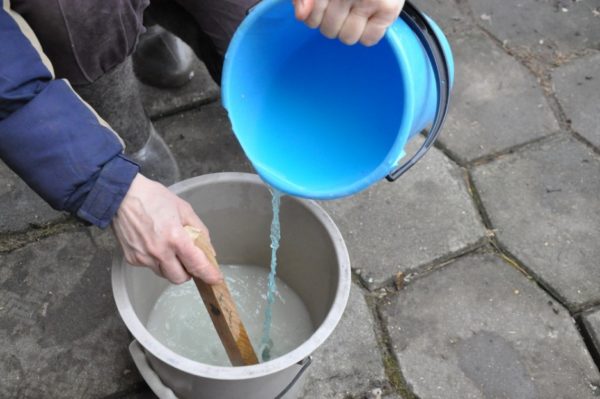 The concentration of copper sulfate or preparations based on it must be observed exactly with the instructions. The regularity and frequency of use depends on the characteristics of the soil and other options for disinfecting the territory. Deviations from instructions and safety rules adversely affect the health status of vegetation, soil quality and can cause harm to human well-being.
The concentration of copper sulfate or preparations based on it must be observed exactly with the instructions. The regularity and frequency of use depends on the characteristics of the soil and other options for disinfecting the territory. Deviations from instructions and safety rules adversely affect the health status of vegetation, soil quality and can cause harm to human well-being.
A negative impact on a person’s condition occurs during soil treatment without personal protective equipment. Particles of copper sulfate penetrate the human body by inhalation, that is, through the respiratory system. Also, this substance enters through the skin.
Copper sulfate intoxication gives the following symptoms:
- redness of the mucous membranes of the eyes;
- lacrimation
- rashes;
- sudden nasal congestion;
- sneezing and coughing;
- muscle weakness;
- chills.
To prevent poisoning while working with copper sulfate-based products, you must follow these safety instructions:
- During the treatment of the soil, make sure that there are no animals and children nearby.
- When handling solutions based on this substance, personal protective equipment is always used that completely covers the skin and mucous membranes - a special suit, respirator, safety glasses, gloves and the like.
- Processing is carried out on a calm day, when the air temperature in the street fluctuates between 5-20 ° C.
- At the end of the work, wash your hands thoroughly and rinse your mouth.
- The rest of the mixture may not be drained into water bodies.
- Soil can not be processed during the flowering period of vegetation.
If copper sulfate solutions get in, it is necessary to immediately rinse the affected skin and mucous membranes with a large volume of running water.
Reviews
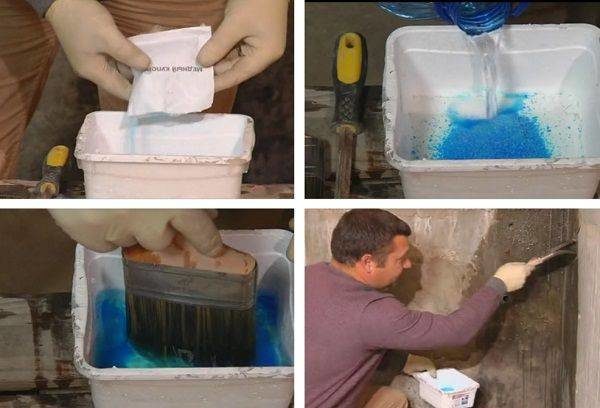 Gardeners and gardeners have been using vitriol-based drugs for decades. These funds are effective, which shows many positive reviews of plant breeders.
Gardeners and gardeners have been using vitriol-based drugs for decades. These funds are effective, which shows many positive reviews of plant breeders.
Olga Vasilievna, 49 years old, Krasnodar Territory
I do the whitewashing of trees 2 times a year - before the appearance of leaves and in November. I use Bordeaux mixture. Trying to whiten the trunk as much as I get. Harvest annually and ample enough.
Fedor, 39, Ivanovo
I am preparing a solution - I take 100 g of m. Vitriol, 10 l of water and 0.7 kg of urea. This all interferes and processes the branches of trees and shrubs, the land in the garden. Such a composition feeds, enriches the soil with the necessary and kills all diseases and parasites.
Valentina, 52, Pyatigorsk
I use mainly Burugnd mixture. In order not to harm, periodically change the copper to iron and back. I also do a whitewash with the help of Bordeaux and every year I have a harvest for my neighbors to envy.
Victor, 59, Nevinnomyssk
I used to use Nitrofen, but now I prefer a Bordeaux mixture. It shows not less result, but as a result costs less money.
There is no one opinion on the most effective tool based on copper sulfate for the processing of garden crops and soil. Each grower has his own secrets of high productivity and a personal scheme for preventive and therapeutic treatments.
Conclusion
Copper sulfate is a proven tool for maintaining the health of crops grown in the garden and in the garden. With a reasonable use of compounds based on copper sulfate in the autumn season next year, plants will gain maximum protection against diseases and pests, and the grower will collect a good crop.

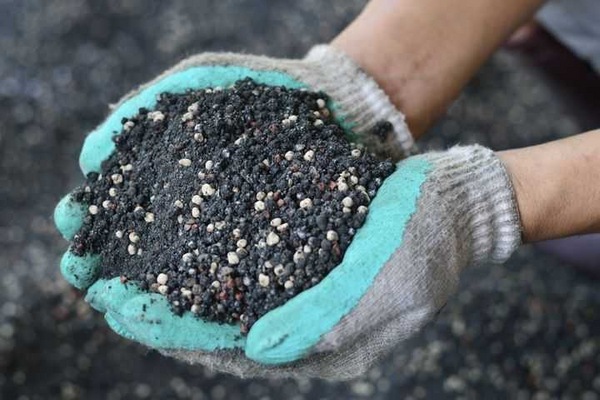
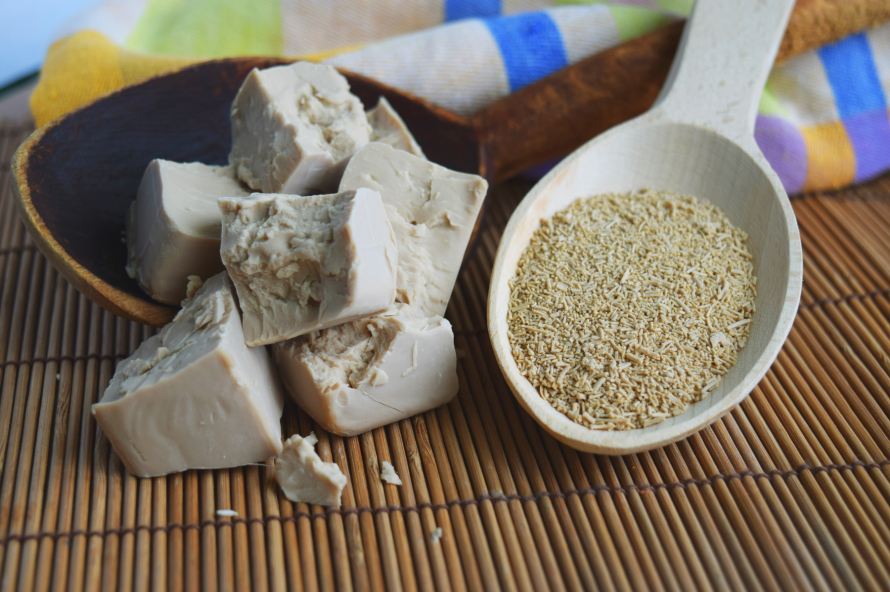
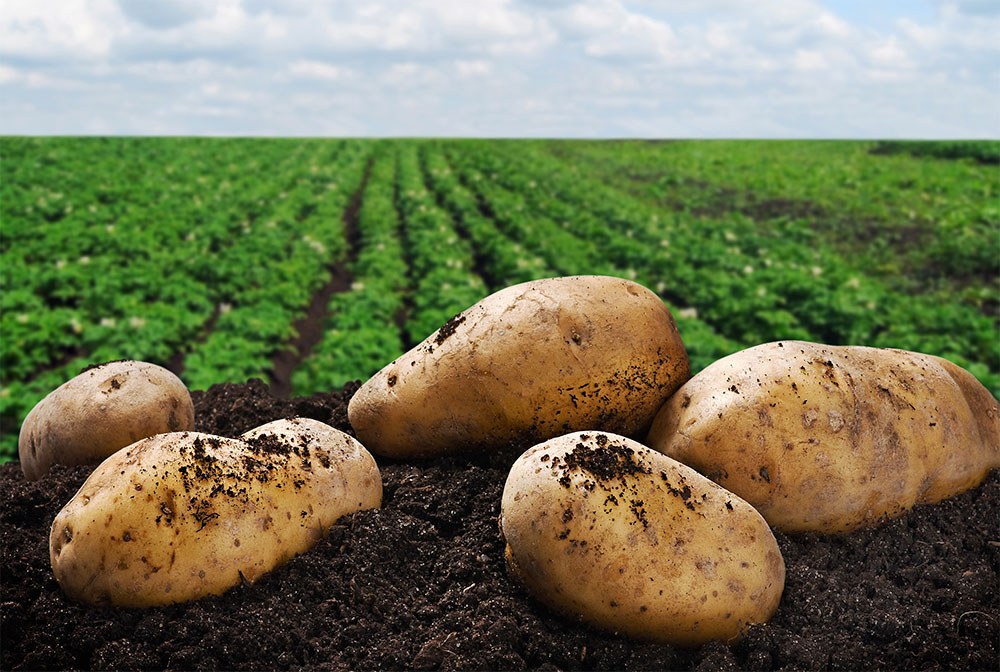
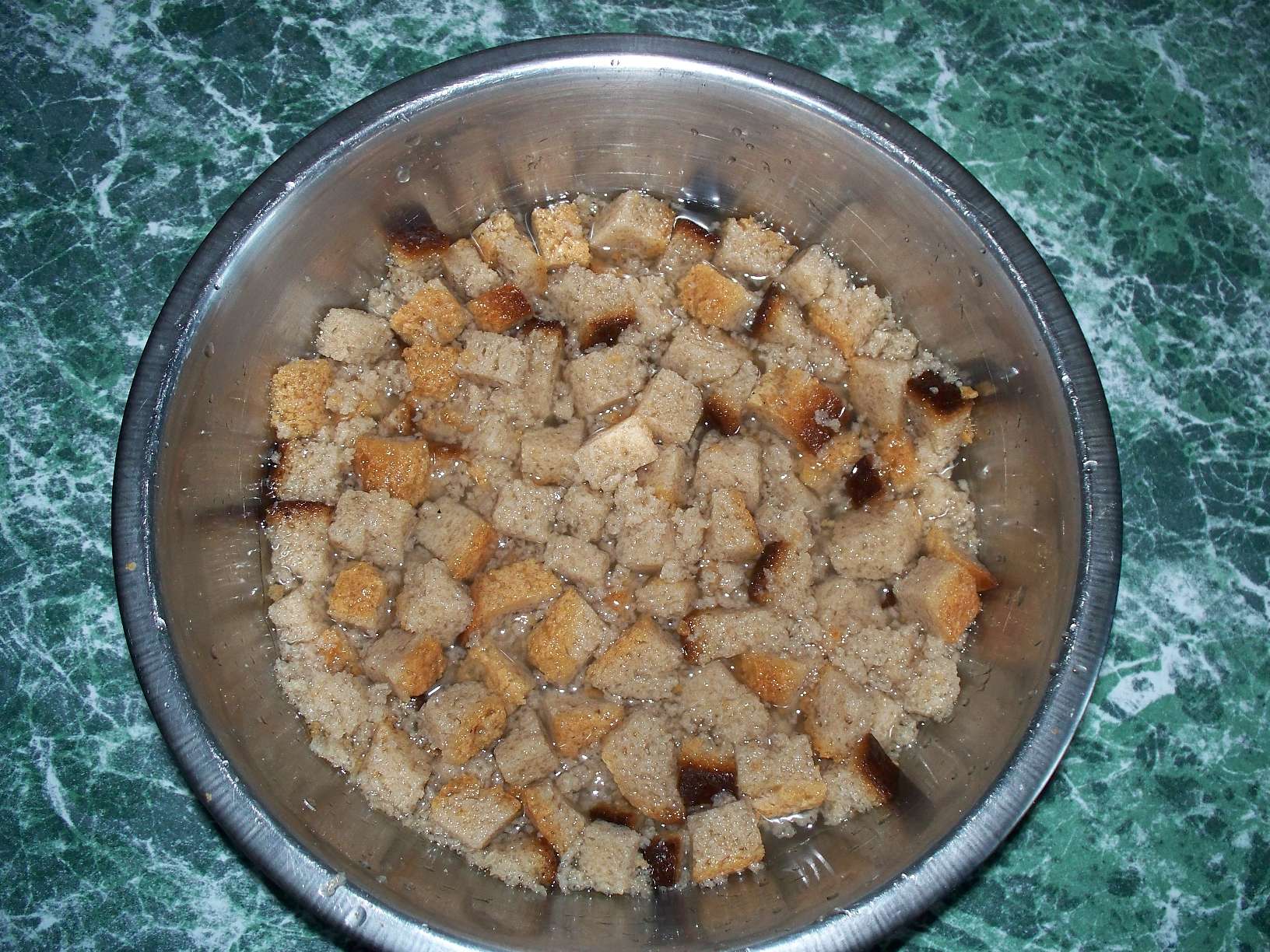 How to make bread infusion for feeding cucumbers
How to make bread infusion for feeding cucumbers Superphosphate: what is it and how to apply it
Superphosphate: what is it and how to apply it What problems can be expected from siderats?
What problems can be expected from siderats? Secrets of the collection, storage and use of eggshells in the garden
Secrets of the collection, storage and use of eggshells in the garden